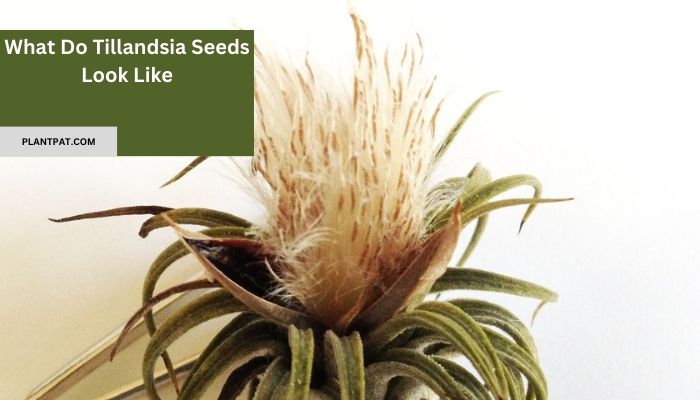
Tillandsia plants may be weirdly shaped, but they’re oh-so-beautiful! Usually propagated by division pups from the mother plant. Tillandsia plants can also be propagated using seeds! But what do Tillandsia seeds look like?
Well! Tillandsia seeds are small and brown with a fluffy top that looks like a halo. Some seeds have a little green nubbin at the end of the coma, which carries the seed in the wind. This signifies that the seed is about to germinate.
The seed’s potential can be seen if you look closely enough. Once germinated, the Tillandsia seed will become the beautiful plant it’s meant to be.
Let’s explore the appearance of Tillandsia seeds, how to identify them, the different types of Tillandsia seeds that exist, and more. So stick till the end!
How to Identify Tillandsia Seeds?
Not sure if your Tillandsia seeds are viable? You’re not alone! Some species show a telltale sign of germination with a little green nubbin at the end of the coma – the tuft of hairs that carry the seed on the wind. But other species may have brown, seemingly lifeless seeds. Here’s how to identify their seeds:
- Size: Tillandsia seeds are very small, about the size of a grain of sand.
- Color: Tillandsia seeds are usually black or brown in color.
- Texture: Tillandsia seeds have a papery texture, making them easily transported by wind.
If you want to know if the seeds you have are from a Tillandsia plant, you can try the following:
- Look at the size of the seed: If the seed is very small, it is likely to be a Tillandsia seed.
- Check the color of the seed: Tillandsia seeds are usually black or brown in color.
- Rub the seed between your fingers: Tillandsia seeds have a papery texture, which should be easy to detect.
Growing Tillandsia from Seed: A Step-by-Step Guide
Now that you know how to identify Tillandsia seeds and the different types that exist, let’s explore how to grow Tillandsia from seed.
Step 1: Prepare Your Materials
To grow Tillandsia from seed, you’ll need a few basic materials:
- Tillandsia seeds
- A growing medium, such as sphagnum moss or peat moss
- A shallow tray or container
- A spray bottle filled with water
Step 2: Prepare Your Growing Medium
If you’re using sphagnum moss or peat moss as your growing medium, you’ll need to moisten it before planting your seeds. Place your growing medium in a shallow tray or container and spray it with water until it is evenly moist.
Step 3: Sow Your Seeds
Sprinkle your Tillandsia seeds over the surface of the growing medium. You don’t need to bury the seeds; they need light to germinate.
Step 4: Provide The Right Conditions
Tillandsia seeds require warm temperatures, high humidity, and bright, indirect light to germinate. Place your tray or container in a warm, humid location, such as near a window with indirect sunlight or under a grow light. To maintain humidity, you can also cover your container with plastic wrap or a clear plastic lid.
Step 5: Maintain Moisture
Keep the growing medium moist by misting it with water regularly using a spray bottle. To maintain humidity, you can also cover your container with a clear plastic lid.
Step 6: Be patient
Tillandsia seeds can germinate anywhere from a few weeks to a few months, so be patient and keep providing the right growing conditions.
Step 7: Transplant
Once your Tillandsia seedlings have grown to a size where they have developed their roots, you can transplant them into a pot or a terrarium filled with a well-draining potting mix. Growing Tillandsia from seed may take some time and effort, but it’s a rewarding process that can yield beautiful and unique plants.
Exploring The Different Types of Tillandsia Seeds
There are over 650 species of Tillandsia, and each species produces seeds that are unique in their characteristics. Here are some of the most common types of Tillandsia seeds:
- T. ionantha seeds: These are some of the smallest Tillandsia seeds and have a silvery-white appearance. They are typically carried by the wind for long distances.
- T. caput-medusae seeds: These seeds are larger than T. ionantha seeds and have a brownish color. They have a tuft of white hairs on one end that helps them to attach to trees or other surfaces.
- T. xerographica seeds: These seeds are among the largest Tillandsia seeds and have a dark brown color. They are typically found in arid regions of Central and South America.
- T. stricta seeds: These seeds are also small and black in color. The wind often carries them and can easily germinate on any surface.
What Are The Steps for Collecting and Growing Air Plant Seeds at Home?
Air plant seeds can be easily raised and planted at home with a few simple steps. These tiny seeds have a wispy white tail that helps them disperse in nature, and when the seed pods open up, they look like puffs of cotton on the plant. Here’s how to collect and grow them:
Collecting The Seeds
When you see the seed pods opening up, collect the seeds and put them in a container with water to soak. They don’t need bright light at this stage, so you can keep the container in a low-light area like your kitchen. Wait for 3-4 weeks until you see tiny green swellings on all the seeds.
Choosing The Growing Medium
The best-growing medium depends on where you live and where you plan to keep the seedlings. If you plan to grow them outside, a fabric with thick strands works well, like a rough cheesecloth or very thin rope. The soft side of Velcro can also be used. Avoid using screen mesh or sphagnum moss, as they may not provide the required moisture.
Planting The Seeds
Gently take the seeds from the water container using tweezers and spread them over the growing medium. Keep them watered every day as best as possible. It’s important to be patient as air plant seeds do not grow quickly. The seeds on Velcro can take around nine months to be ready for transplantation.
Conclusion
Tillandsia seeds may be tiny, but they contain enormous potential. Their unique, otherworldly appearance and versatility make them truly fascinating little plant products.
Whether you’re interested in identifying different types of Tillandsia seeds, growing Tillandsia from seed, or using Tillandsia seeds in creative crafting projects, there are plenty of exciting opportunities to explore.
By following the steps outlined in this guide, you can learn how to use Tillandsia seeds to create your own little pieces of paradise. So, next time you come across a Tillandsia plant or seed pod, take a closer look. You might be surprised by what you find.
With a little bit of curiosity and creativity, you can unlock the full potential of these incredible plants and seeds.
